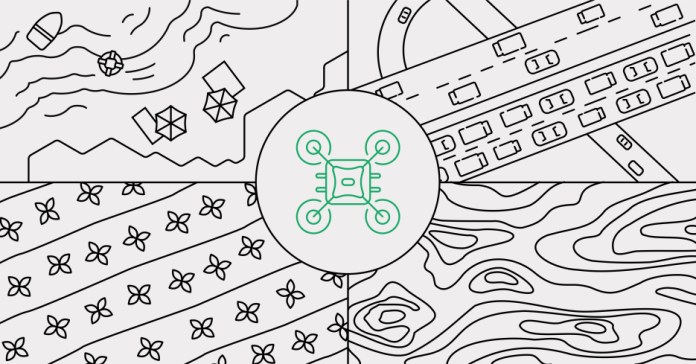Believe it or not, unmanned aerial vehicles (UAVs) have been in use for about 100 years in some shape or form, even though drones seem like newer technology. Regardless, there is no denying that drones are now more easily accessible for individuals and organizations alike to use for a wide variety of applications, and real-time kinematic positioning (RTK) technology is increasingly used to deliver highly accurate navigation data and positioning.
Today, UAVs are quickly becoming the standard method of capturing critical geospatial information and are increasingly used for recreational activities. Some top applications for drones include surveying, mapping, surveillance, photography and farming.
While these use cases all have unique workflows and goals, they tend to share one common objective: reality determination. UAVs are particularly helpful for this as they can not only capture imagery but also the imagery’s precise location. Drone operators can transform the captured imagery into actionable data for their particular use case, using this positioning data to georeference the image onto the earth’s surface.

UAVs not only capture imagery but also the imagery’s precise location, which can be used to georeference the image onto the earth’s surface. (Source: Point One Navigation Inc.)
Drone positioning inaccuracies can be corrected with RTK
Despite the rapid evolution of geospatial technology and the rise in popularity of drones, achieving high-precision positioning information is not always easy. UAV positioning is typically derived using GNSS, with accuracy that can be impacted by a host of different factors. Correcting these GNSS signal inaccuracies is often complex but crucial for drone operators to ensure the information they are collecting is usable.
RTK is one method of correcting the GNSS signal inaccuracies of a drone. RTK corrections are essentially derived by calculating the positional discrepancy between a drone and the nearby base station, and the result is centimeter-level accuracy. This high-precision positioning not only makes the data captured by the drone more productive, but it also unlocks further potential for new, innovative use cases.

RTK corrections are derived by calculating the positional discrepancy between a nearby base station and the drone for centimeter-level accuracy positioning. (Source: Point One Navigation Inc.)
Fortunately, RTK networks like Point One Polaris mean UAV operators can harness the power of high-precision signal corrections without having to set up a base station or perform complicated calculations themselves. Instead, they can focus on drone flying and collecting the data they need—at the required precision—for their specific goal.
Top six reasons why your robot or drone needs RTK
Not convinced? Here are our top six reasons for RTK-enabling your robot or drone.
Remove the need to set up your own GCPs
In order to later rectify data collected in-flight for more accurate positioning, many drone operators still set up their own ground control points (GCPs) or base stations with known locations. By leveraging a modern RTK network like Polaris while flying your drone, you can simply achieve centimeter-level accuracy by accessing over 1,440 global base stations—all without having to set up your own GCP. With RTK, you spend more time using and collecting the data you need and less time preparing to capture it.
Drastically reduce post-processing time
Likewise, RTK reduces the amount of time you need to process data post-flight. Any mapping, photogrammetry or LiDAR frame matching requires post-processing work on a computer to accurately georeference the data collected and make it usable. RTK corrections acutely decrease this effort by providing high-precision positioning from the outset. For example, a recent case study found that RTK-enabled drones reduce post-processing time by 90%.
Simplify navigation workflows and path planning
RTK also makes your drone’s flight path easy to plan and set up. As you prepare to capture data with a UAV, you no longer need to waste time surveying and setting up GCPs to guarantee your drone stays on track. RTK allows your drone to accurately navigate in the real world by correcting any GNSS signal inaccuracies in real time, based on the x, y and z dimensions of your pre-programmed flight path. As a bonus, you won’t need to post-process GCP locations.
Avoid collisions with confidence
In an increasingly crowded airspace, it is crucial to detect and avoid collisions with objects. Whether you’re simply trying to avoid a crash or operating an entire drone fleet, RTK provides the high-precision positioning needed to understand where your UAV is relative to potential obstacles. A well-functioning RTK integrated with path-planning tools prevents costly collisions before they happen.
Take advantage of a flight history with unprecedented observability
No technical solution is perfect, and while RTK is a game-changer for producing high-precision results, it can also help operators discern the position of any remaining inaccuracies. Properly diagnosing in-flight problems requires observability into flight history, including timestamped locations. For example, for any RTK-enabled device, the GraphQL API makes it possible to send one simple HTTPS request and receive plain, well-formed JSON data in return, providing an unprecedented level of observability for drone operators.
Enjoy expanded use of your UAV
With all of the time saved and the new drone insights that RTK delivers, you can now explore new and innovative ways to apply data captured by your UAV. Daily, new use cases for drones are introduced, and RTK will continue to play an indispensable role in securing high-precision positioning in these expanded applications. RTK currently powers the foundational positioning data behind inspection, precision agriculture, volumetric measurement and a host of other location-based use cases.
Advertisement










